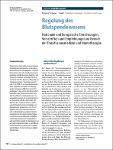Regelung des Blutspendewesens
Nationale und Europäische Einrichtungen, Vorschriften und Empfehlungen im Bereich der Transfusionsmedizin und Hämotherapie
Kroczek, Richard
Burger, Reinhard
Seitz, R.
Dieser Beitrag beschreibt die verschiedenen nationalen und europäischen Institutionen, Kommittees, Zulassungsbehörden und Richtlinien, die das deutsche Transfusionssystem regulieren und die für dessen Qualitäts- und Sicherheitsstandards zuständig sind. An erster Stelle steht das „Gesetz zur Regelung des Transfusionswesens (Transfusionsgesetz)” vom 1. Juli 1998. Ein weiteres Regelungselement stellen die „Richtlinien zur Blutgruppenbestimmung und Bluttransfusion (Hämotherapie)” dar, welche vom Wissenschaftlichen Beirat der Bundesärztekammer und dem Paul-Ehrlich-Institut gemeinsam herausgegeben werden. Als ein weiteres Gremium beschäftigt sich der „Arbeitskreis (AK) Blut” mit dem Stand der Technik und Wissenschaft in der Transfusionsmedizin und Hämotherapie. Kompetenzen und Zuständigkeiten der unterschiedlichen Bundes- und Landesbehörden und deren Interaktionsebenen mit den medizinischen Fachgesellschaften werden dargelegt. Schließlich werden die europäischen Organisationen und Kommittees sowohl des Europarates wie auch der Europäischen Union vorgestellt, die an der Erarbeitung europaweiter Standards und Richtlinien für die Transfusionsmedizin beteiligt sind. This article describes the various national and European institutions, committees, guidelines and regulatory bodies shaping and safeguarding the standards of the German transfusion medicine system. It refers to the content of the Transfusion Medicine Act issued in 1998 by the German parliament, the national guidelines of the German Medical Association, and the work of the „Arbeitskreis Blut”, a working party on acute issues arising in the transfusion medicine area. It covers the way the various German federal (Ministry of Health, Paul-Ehrlich-Institut, Robert Koch-Institut) and land regulatory bodies interact with experts of the various German Medical Societies to ensure a high medical standard within the transfusion medicine system. Finally, it describes the European organizations and committees, both within the Council of Europe and the European Union, which are involved in shaping European standards and guidelines in transfusion medicine.
No license information

